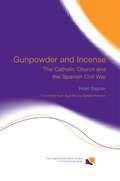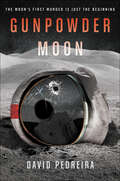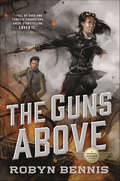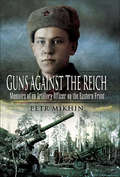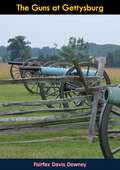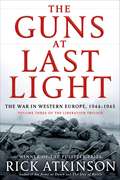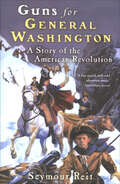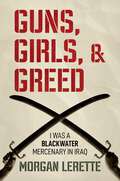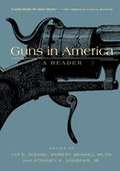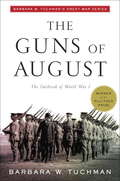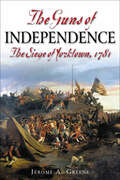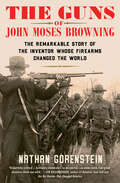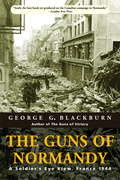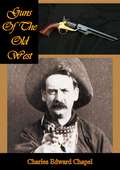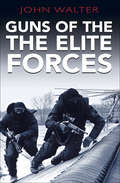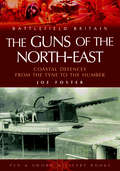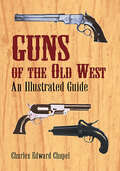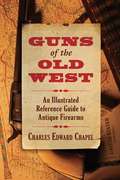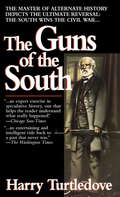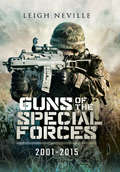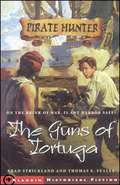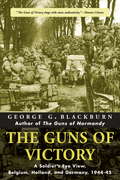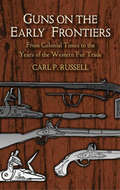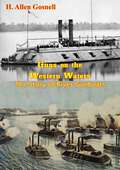- Table View
- List View
Gunpowder and Incense: The Catholic Church and the Spanish Civil War (Routledge/Canada Blanch Studies on Contemporary Spain)
by Hilari RaguerNow available in English for the first time, Gunpowder and Incense (translated from the Spanish La Pólvora y el Incienso) chronicles the role of the Church in Spanish politics, looking in particular at the Spanish Civil War. Unlike most books on the subject, Hilari Raguer looks beyond the traditional explanation that the war was primarily a religious struggle. His writing presents an exemplary "insider's" perspective, and is notable for its balance and perception on the role of the Catholic Church before, during and after the War. The material is presented in a lucid, elegant manner - which makes this book as readable as it is historiographically important. It will be vital reading for students and scholars of European, religious and modern history.
Gunpowder Moon
by David PedreiraAn Amazon Best Books of the Year selectionBookBub Breakout Debut Novels of Winter 2018The Verge―18 Science Fiction and Fantasy Books to Read in FebruaryBarnes & Noble—One of 25 Sci-Fi/Fantasy Debuts to Watch for in 2018Nerdmuch—Best New Sci-Fi & Fantasy Books of 2018Bookish—Winter 2018’s Hottest Sci-Fi and Fantasy BooksLibrary Journal: Spring/Summer Best Debut Novels“Interesting quirks and divided loyalties flesh out this first novel in which sf and mystery intersect in a well-crafted plot...Pedreira’s science thriller powerfully highlights the human politics and economics from the seemingly desolate expanse of the moon. It will attract readers who enjoyed Andy Weir’s lunar crime caper Artemis.” -- Library Journal, starred reviewA realistic and chilling vision of life on the Moon, where dust kills as easily as the vacuum of space…but murder is even quicker—a fast-paced, cinematic science fiction thriller, this debut novel combines the inventiveness of The Martian, the intrigue of The Expanse, and the thrills of Red Rising.The Moon smells like gunpowder. Every lunar walker since Apollo 11 has noticed it: a burnt-metal scent that reminds them of war. Caden Dechert, the chief of the U.S. mining operation on the edge of the Sea of Serenity, thinks the smell is just a trick of the mind—a reminder of his harrowing days as a Marine in the war-torn Middle East back on Earth.It’s 2072, and lunar helium-3 mining is powering the fusion reactors that are bringing Earth back from environmental disaster. But competing for the richest prize in the history of the world has destroyed the oldest rule in space: Safety for All. When a bomb kills one of Dechert’s diggers on Mare Serenitatis, the haunted veteran goes on the hunt to expose the culprit before more blood is spilled.But as Dechert races to solve the first murder in the history of the Moon, he gets caught in the crosshairs of two global powers spoiling for a fight. Reluctant to be the match that lights this powder-keg, Dechert knows his life and those of his crew are meaningless to the politicians. Even worse, he knows the killer is still out there, hunting.In his desperate attempts to save his crew and prevent the catastrophe he sees coming, the former Marine uncovers a dangerous conspiracy that, with one spark, can ignite a full lunar war, wipe out his team . . . and perhaps plunge the Earth back into darkness.
The Guns Above: A Signal Airship Novel (The Signal Airship Novels #1)
by Robyn BennisRobyn Bennis’s THE GUNS ABOVE is an adventurous military fantasy debut about a nation's first female airship captain.They say it’s not the fall that kills you. For Josette Dupre, the Corps’ first female airship captain, it might just be a bullet in the back. On top of patrolling the front lines, she must also contend with a crew who doubts her expertise, a new airship that is an untested deathtrap, and the foppish aristocrat Lord Bernat, a gambler and shameless flirt with the military know-how of a thimble. Bernat’s own secret assignment is to catalog her every moment of weakness and indecision. So when the enemy makes an unprecedented move that could turn the tide of the war, can Josette deal with Bernat, rally her crew, and survive long enough to prove herself?“Full of sass and terrific characters. Great storytelling. Loved it.” —Patricia BriggsAt the Publisher's request, this title is being sold without Digital Rights Management Software (DRM) applied.
Guns Against the Reich: Memoirs of an Artillery Officer on the Eastern Front (Stackpole Military History Ser.)
by Petr Mikhin&“[A] powerful autobiography from a Russian veteran of Stalingrad, Kursk and numerous other battles . . . as he fought his way from Moscow to Vienna.&” —Military Illustrated In three years of war on the Eastern Front—from the desperate defense of Moscow, through the epic struggles at Stalingrad and Kursk to the final offensives in central Europe—artillery-man Petr Mikhin experienced the full horror of battle. In this vivid memoir he recalls distant but deadly duels with German guns, close-quarter hand-to-hand combat, and murderous mortar and tank attacks, and he remembers the pity of defeat and the grief that accompanied victories that cost thousands of lives. He was wounded and shell-shocked, he saw his comrades killed and was nearly captured, and he was threatened with the disgrace of a court martial. For years he lived with the constant strain of combat and the ever-present possibility of death. Mikhin recalls his experiences with a candor and an immediacy that brings the war on the Eastern Front—a war of immense scale and intensity—dramatically to life.&“Mikhin&’s memoirs give us a very valuable picture of life in the Red Army during four years of intense non-stop fighting against a determined and skilled enemy. This allows us to follow the evolution of the Red Army from the nearly defeated force of 1941 to the skilled military machine of 1945, and helps illuminate the price that the Soviet soldiers paid for victory.&” —History of War&“A fast-paced, interesting read that recounts stories of courage under fire and dedication to duty . . . I highly recommend this book.&” —Military Review
Guns at Cassino (Wotan Series)
by Leo Kessler[from the back cover] "ON PEAK 555, towering above the Italian town of Cassino, the exhausted, shell-shocked survivors of SS Assault Regiment Wotan held out against the combined forces of the Allied armies. First came the Americans, then the fearless Sikhs, and finally the British infantry, in a merciless assault on the key stronghold of the Italian front. Although the battle was lost, the SS code forbade them to surrender. It was Major Kuno von Dodenburg's job to get what was left of the battalion out alive. But first he had to get his hands on the traitor in their midst..."
The Guns at Gettysburg
by Fairfax Davis DowneyThe guns still stand at Gettysburg amid the markers and the monuments on the hallowed ground. And it is fitting that they do, for Gettysburg marked not only the high tide of the Confederacy and the turning point of the war, but also the greatest cannonade ever seen in this hemisphere. In no battle of the Civil War did artillery play a more decisive role than it did here, and no factor contributed more to the Union victory than the superior handling of the Federal cannon. Amid all the discussions of the errors of generalship on both sides, too little credit has been given to that all-but-forgotten hero of the battle, General Henry Jackson Hunt, the chief of the Union artillery. In reappraising and retelling the battle form the artilleryman’s point of view, Colonel Downey has made a real contribution to our understanding of the reasons for the Confederate failure to crush the Army of the Potomac.
The Guns at Last Light: The War in Western Europe, 1944-1945 (The Liberation Trilogy #3)
by Rick Atkinson<p>The magnificent conclusion to Rick Atkinson's acclaimed Liberation Trilogy about the Allied triumph in Europe during World War II. It is the twentieth century's unrivaled epic: at a staggering price, the United States and its allies liberated Europe and vanquished Hitler. <p>In the first two volumes of his bestselling Liberation Trilogy, Rick Atkinson recounted how the American-led coalition fought through North Africa and Italy to the threshold of victory. Now, in <i>The Guns at Last Light</i>, he tells the most dramatic story of all, the titanic battle for Western Europe. <p>D-Day marked the commencement of the final campaign of the European war, and Atkinson's riveting account of that bold gamble sets the pace for the masterly narrative that follows. The brutal fight in Normandy, the liberation of Paris, the disaster that was Operation Market Garden, the horrific Battle of the Bulge, and finally the thrust to the heart of the Third Reich-all these historic events and more come alive with a wealth of new material and a mesmerizing cast of characters. <p>Atkinson tells the tale from the perspective of participants at every level, from presidents and generals to war-weary lieutenants and terrified teenage riflemen. When Germany at last surrenders, we understand anew both the devastating cost of this global conflagration and the enormous effort required to win the Allied victory. <p>With the stirring final volume of this monumental trilogy, Atkinson's accomplishment is manifest. He has produced the definitive chronicle of the war that unshackled a continent and preserved freedom in the West.</p>
Guns for General Washington: A Story of the American Revolution (Great Episodes)
by Seymour ReitA tale of courage and bravery—the daring and dangerous trek that gave young America its first real victory, paving the way for the future of a great democratic nation.This exciting middle grade novel is the true story of Will Knox, a nineteen-year-old young man who transported 183 cannons from New York’s Fort Ticonderoga to Boston—in the dead of winter—to help George Washington win an important battle.Paul Revere's midnight ride...Washington crossing the Delaware...the winter crisis at Valley Forge... Some events in America's War for Independence are known to all. This book brings to history fans the story of another true episode, just as dramatic but not nearly as well known.As you read these pages, you will agree that Colonel Knox's great adventure was a stirring, suspenseful, and important event in American history.
Guns, Girls, and Greed: I Was a Blackwater Mercenary in Iraq
by Morgan LeretteGuns, Girls, and Greed is an unvarnished, behind-the-scenes, tell-all account of the scathing and dangerous life of mercenaries at war in Iraq.Experience the world of private contractors conducting high-threat missions for a nascent Iraqi government in the hopes of rebuilding after the fall of Saddam Hussein. With limited support, the men of Blackwater protected US diplomats as the country descended into sectarian violence. It was a hazardous mission complete with rockets, mortars, improvised explosive devices, and not knowing who or where the enemy was. Morgan Lerette&’s irreverently honest memoir shows the good and bad of injecting private armies into active combat zones in the name of diplomacy and digs deep into the bonds of brotherhood created by war. With gut-wrenching tragedy, dark humor, and parties that make Animal House seem like a Disney film, this memoir offers a firsthand perspective on how men act and react in war. Lerette, a private contractor employed by the notorious Blackwater in the early days of the Iraq War, pulls no punches in calling out the incompetence of both the US military and the Department of State during the collapse of Iraq. You can decide if the insertion of private contractors in Iraq assisted or detracted from the war effort and if the costs in blood and treasure were worth the carnage.
Guns In America: A Historical Reader
by Jan E. Dizard Robert Muth Stephen P. AndrewsFirearms have long been at the core of our national narratives. From the Puritans' embrace of guns to beat back the "devilish Indian" to our guilty delight in the extralegal exploits of Dirty Harry, Americans have relied on the gun to right wrongs, both real and imagined. <p><p> The extent to which guns have been woven into our nation's mythology suggests that the current debate is only partly about guns themselves and equally about conflicting cultural values and competing national identities. Belying the gun debate are a host of related issues: contesting conceptions of community, the proper relationship between the individual and the state, and the locus of responsibility for maintaining order. <p> Guns in America documents and analyzes the history of firearms in America, exploring various aspects of gun manufacture, ownership, and use—and more importantly, the cultural and political implications which this history reveals. <p> Eschewing single-minded partisanship and emphasizing nuance and compromise, Jan E. Dizard and Robert Merrill Muth have assembled a diverse array of writings from all points on the ideological spectrum. The documents span the whole of American history, from Puritan sermons to contemporary NRA documents. The result is an indispensable panorama of the never-ending controversies over gun control, crime, hunting, and militias.
The Guns of August: The Outbreak of World War I
by Barbara W. TuchmanIn this landmark account, renowned historian Barbara W. Tuchman re-creates the first month of World War I: thirty days in the summer of 1914 that determined the course of the conflict, the century, and ultimately our present world. Beginning with the funeral of Edward VII, Tuchman traces each step that led to the inevitable clash. And inevitable it was, with all sides plotting their war for a generation. Dizzyingly comprehensive and spectacularly portrayed with her famous talent for evoking the characters of the war’s key players, Tuchman’s magnum opus is a classic for the ages.<P><P> Pulitzer Prize Winner
The Guns of Independence: The Siege of Yorktown, 1781
by Jerome A. GreeneA modern, scholarly account of the most decisive campaign during the American Revolution examining the artillery, tactics and leadership involved.The siege of Yorktown in the fall of 1781 was the single most decisive engagement of the American Revolution. The campaign has all the drama any historian or student could want: the war’s top generals and admirals pitted against one another; decisive naval engagements; cavalry fighting; siege warfare; night bayonet attacks; and much more. Until now, however, no modern scholarly treatment of the entire campaign has been produced.By the summer of 1781, America had been at war with England for six years. No one believed in 1775 that the colonists would put up such a long and credible struggle. France sided with the colonies as early as 1778, but it was the dispatch of 5,500 infantry under Comte de Rochambeau in the summer of 1780 that shifted the tide of war against the British.In early 1781, after his victories in the Southern Colonies, Lord Cornwallis marched his army north into Virginia. Cornwallis believed the Americans could be decisively defeated in Virginia and the war brought to an end. George Washington believed Cornwallis’s move was a strategic blunder, and he moved vigorously to exploit it. Feinting against General Clinton and the British stronghold of New York, Washington marched his army quickly south. With the assistance of Rochambeau's infantry and a key French naval victory at the Battle off the Capes in September, Washington trapped Cornwallis on the tip of a narrow Virginia peninsula at a place called Yorktown. And so it began.Operating on the belief that Clinton was about to arrive with reinforcements, Cornwallis confidently remained within Yorktown’s inadequate defenses. Determined that nothing short of outright surrender would suffice, his opponent labored day and night to achieve that end. Washington’s brilliance was on display as he skillfully constricted Cornwallis’s position by digging entrenchments, erecting redoubts and artillery batteries, and launching well-timed attacks to capture key enemy positions. The nearly flawless Allied campaign sealed Cornwallis’s fate. Trapped inside crumbling defenses, he surrendered on October 19, 1781, effectively ending the war in North America.Penned by historian Jerome A. Greene, The Guns of Independence: The Siege of Yorktown, 1781 offers a complete and balanced examination of the siege and the participants involved. Greene’s study is based upon extensive archival research and firsthand archaeological investigation of the battlefield. This fresh and invigorating study will satisfy everyone interested in American Revolutionary history, artillery, siege tactics, and brilliant leadership.
The Guns of John Moses Browning: The Remarkable Story of the Inventor Whose Firearms Changed the World
by Nathan GorensteinThe first major biography of &“the Thomas Edison of guns,&” John Moses Browning, a visionary inventor who designed the modern handgun and whose awe-inspiring array of firearms helped ensure victory in numerous American wars and found an important place in American culture. Few people are aware that John Moses Browning—a tall, humble, cerebral man born in 1855 and raised as a Mormon in the American West—was the mind behind many of the world-changing firearms that dominated more than a century of conflict. He invented the crucial design used in virtually all modern pistols, created the most popular hunting rifles and shotguns, and conceived the machine guns that proved decisive not just in World Wars I and II but nearly every major military action since. Yet few in America knew his name until he was into his sixties. Now, author Nathan Gorenstein brings firearms inventor John Moses Browning to vivid life in this riveting and revealing biography. Embodying the tradition of self-made, self-educated geniuses (like Lincoln and Edison), Browning was able to think in three dimensions (he never used blueprints) and his gifted mind produced everything from the famous Winchester &“30-30&” hunting rifle to the awesomely effective machine guns used by every American aircraft and infantry unit in World War II. The British credited Browning&’s guns with helping to win the Battle of Britain. His inventions illustrate both the good and bad of weapons. Sweeping, lively, and brilliantly told, this fascinating book introduces a little-known American legend whose impact on history ranks with that of the Wright Brothers, Thomas Edison, and Henry Ford.
The Guns of Normandy
by George BlackburnIn the weeks after D-Day, the level of artillery action in Normandy was unprecedented. In what was a relatively small area, both sides bombarded each other relentlessly for three months, each trying to overwhelm the other by sheer fire power.The Guns of Normandy puts the reader in the front lines of this horrific battle. In the most graphic and authentic detail, it brings to life every aspect of a soldier's existence, from the mortal terror of impending destruction, to the unending fatigue, to the giddy exhilaration at finding oneself still, inexplicably, alive.The story of this crucial battle opens in England, as the 4th Field Regiment receives news that something big is happening in France and that after long years of training they are finally going into action. The troop ships set out from besieged London and arrive at the D-Day beaches in the appalling aftermath of the landing.What follows is the most harrowing and realistic account of what it is like to be in action, as the very lead man in the attack: an artillery observer calling in fire on enemy positions. The story unfolds in the present tense, giving the uncomfortably real sense that "You are here."The conditions under which the troops had to exist were horrific. There was near-constant terror of being hit by incoming shells; prolonged lack of sleep; boredom; weakness from dysentery; sudden and gruesome deaths of close friends; and severe physical privation and mental anguish. And in the face of all this, men were called upon to perform heroic acts of bravery and they did. Blackburn provides genuine insight to the nature of military service for the average Canadian soldier in the Second World War - something that is all too often lacking in the accounts of armchair historians and television journalists. The result is a classic account of war at the sharp end.From the Hardcover edition.
Guns Of The Old West: An Illustrated Reference Guide To Antique Firearms
by Charles Edward ChapelAn Essential Compendium for Any Firearms or Old West Aficionado, richly and comprehensively illustrated.Written by one of the foremost firearms experts of the twentieth century, Charles Edward Chapel's Guns of the Old West is an exhaustively researched document that not only boasts a significant collection of antique Western guns, but also categorizes the firearms into easy-to-reference sections.Starting with an introductory chapter on the origins of guns and their earliest uses on the frontier, Chapel covers everything from muskets to rifles, pistols to revolvers, and shotguns to martial arms. Three whole chapters are dedicated to the rise and fall of the famous Deringer pistol. And as much as Guns of the Old West is an encyclopedic reference manual, it also contains fascinating historical literature that frames the world in which these guns were used. Buffalo guns and hunters are covered, along with martial arms of the post-Civil War era. The gun collection of famous collector and hunter President Theodore Roosevelt is given its own chapter.Illustrated with nearly five hundred illustrations, as well as important artwork from the Western period from artists such as Frederic Remington, Guns of the Old West is an essential work for gun collectors and American history enthusiasts.
Guns of the Elite Forces
by John WalterGuns of the Elite Forces provides a penetrating account of the weapons that elite fighting troops carry into combat. Such elites have always existed in the armies of the world. During World War II, elite units sprang up in most theatres of conflict the German Brandenburgers carried out clandestine operations in Poland; in the Western Desert, the Long Range Desert Group and SAS penetrated deep behind enemy lines; for larger-scale raids the British Commandos and the US Rangers and Marine Raiders were formed.
The Guns of the Northeast: Costal Defences from the Tyne to the Humber (Battlefield Britain)
by Joe FosterA graphic account of the defence of Hartlepool, Whitby and Scarborough against German seaborne raiders in 1914 and a detailed history the coastal defences that confronted the German navy. For the first time the author relates the wider story of the batteries of the Northeast of England and of the gunners who manned them in times of war and peace. His study covers all the coastal batteries from Northumberland and the Tyne, south through Wearside and Durham, Hartlepool and the Tees, to North Yorkshire and the Humber. Information on all the sites of the gun batteries along the coast is included. Published in association with the Heugh Battery Restoriation Trust.
Guns of the Old West: An Illustrated Guide (Dover Military History, Weapons, Armor)
by Charles Edward ChapelFirearms played an important role on the American frontier. Used to hunt animals for food and clothing, they also safeguarded one’s home against outlaws and other hostile elements. This definitive, scrupulously researched work describes and illustrates the many different weapons that opened up and secured the American West. Enhanced with colorful anecdotes, the vividly detailed narrative tells the dramatic story of shoulder arms, hand guns, percussion and cartridge weapons, and describes the hunters, settlers, peace officers, stagecoach drivers, soldiers, range detectives, rustlers, outlaws, Indian chiefs, and other picturesque characters who used them.Here are detailed descriptions and illustrations of the Kentucky rifle that saw battle in the American Revolution and in the War of 1812; the repeating rifle used in the Civil War; the Sharps rifle that wreaked havoc during the great buffalo hunts; the Colt revolver, used by cowboys and outlaws alike; the fast and reliable Winchester rifle, the most widely used shoulder arm of the post-Civil War era; as well as flintlock pistols, derringers, muskets, buffalo guns, carbines, signal pistols, Confederate revolvers, and many other celebrated firearms.Illustrated with nearly 500 photographs and line illustrations, this classic reference will not only be invaluable to dealers and collectors but will also appeal to Americana devotees, weaponry enthusiasts, and students of the American West.
Guns of the Old West: An Illustrated Reference Guide to Antique Firearms
by Charles Edward ChapelWritten by one of the foremost firearms experts of the twentieth century, Charles Edward Chapel’s Guns of the Old West is an exhaustively researched document that not only boasts a significant collection of antique Western guns, but also categorizes the firearms into easy-to-reference sections.Starting with an introductory chapter on the origins of guns and their earliest uses on the frontier, Chapel covers everything from muskets to rifles, pistols to revolvers, and shotguns to martial arms. Three whole chapters are dedicated to the rise and fall of the famous Deringer pistol. And as much as Guns of the Old West is an encyclopedic reference manual, it’s also fascinating historical literature that frames the world in which these guns were used. Buffalo guns and hunters are covered, along with martial arms of the post–Civil War era. The gun collection of famous collector and hunter President Theodore Roosevelt is given its own chapter.Illustrated with nearly 500 illustrations, as well as important artwork from the Western period from artists such as Frederic Remington, Guns of the Old West is an essential work for gun collectors and American history enthusiasts.
The Guns of the South: A Novel
by Harry Turtledove"It is absolutely unique--without question the most fascinating Civil War novel I have ever read." Professor James M. McPherson, Pultizer Prize-winning BATTLE CRY OF FREEDOM. January 1864--General Robert E. Lee faces defeat. The Army of Northern Virginia is ragged and ill-equpped. Gettysburg has broken the back of the Confederacy and decimated its manpower.Then, Andries Rhoodie, a strange man with an unplaceable accent, approaches Lee with an extraordinary offer. Rhoodie demonstrates an amazing rifle: Its rate of fire is incredible, its lethal efficiency breathtaking--and Rhoodie guarantees unlimited quantities to the Confederates. The name of the weapon is the AK-47....Selected by the Science Fiction Book Club. A Main Selection of the Military Book Club.
Guns of the Special Forces, 2001–2015
by Leigh NevilleAn in-depth look at the weaponry employed by Special Forces units around the world following the September 11th attacks. In the years since 9/11, Special Forces of many nations have been in almost constant action in covert, high risk operations around the globe. These include the two long conflicts in Iraq and Afghanistan, fighting nationalist insurgents and jihadist terrorists, as well as other lesser-known operations. The weapons used by SF are a constant source of interest and speculation, as are SF training, methods and vehicles. The armories of these elite units have developed rapidly to meet their demands and the ever more sophisticated threat. They include for example suppressed piston-driven carbines, programmable grenade launchers that airburst behind hidden enemy, and sniper rifles of extreme accuracy and range. This highly researched book gives the reader a privileged insight into this secret world, exploring the custom-built weapons that operators carry on capture/kill missions in the 21st Century.Praise for Guns of Special Forces&“A cut above most of the books that purport to review special ops weapons. Its limitation to the War on Terror years allows coverage of the many weapon developments that have taken place as special operations units have been constantly deployed and in action over the last decade and a half.&” —SWAT Magazine
The Guns of Tortuga
by Dominick Saponaro Brad Strickland Thomas E. FullerSafe Harbor? Five months into their undercover search for the pirate Jack Steele, Captain Hunter and the Aurora head for the island of Tortuga to put in for repairs after a battle with a deadly Spanish ship. Davy Shea, now fifteen years old and accepted by the Aurora's crew, continues to help his uncle Patch in the ship's surgery, but Captain Hunter has a special mission for him. The Captain has learned that captured British officers are being held on the island for ransom from the Crown, and he is determined to rescue those officers, even risking the Aurora's cover. As a servant boy, Davy can easily pass among the various pirate groups thriving on Tortuga. But as Davy begins to uncover the many secrets and deceptions that shroud this beautiful island, he soon realizes that more is at stake than the lives of a few captured officers. A plan is in the works that will force the pirate hunters on the Aurora to make new alliances...and bring them face to face with former enemies.
The Guns of Victory
by George BlackburnFor the Canadian Soldiers who lived through the momentous battle for Normandy in the summer of 1944, it was inconceivable that the conflict in Europe could continue for another eight long months. The war was won, they thought, and to win it they had been pushed to what seemed like the limits of endurance. But ahead lay not only an enemy with no thoughts of surrender, but also appalling battle conditions reminiscent of the legendary miseries of Passchendaele. This much-anticipated sequel to The Guns of Normany picks up where its critically acclaimed predecessor leaves off, and it continues in the same absorbing, startlingly vivid style. After the battle for Normandy, Blackburn's 4th Field Regiment, with the rest of 1st Canadian Army, is called upon to pursue the enemy through the flooded Low Country, clearing the Scheldt estuary - a task equal to that of D-Day - and opening the port of Antwerp to allow for the huge influx of supplies necessary to press on against the German forces, now fighting with mounting desperation and ferocity. After enduring the worst winter in local memory, and spending yet another Christmas far from home, in the spring of 1945 the Canadians are thrust into the crucial Battle of the Rhineland, which will eventually allow Allied forces to plunge into the heart of the Reich.When victory comes, it is with no sense of triumph over a vanquished foe, but with the profoundest relief that this most terrible conflict in history is finally over.Told with Blackburn's now trademark sense of drama and eye for detail, this story of the desperate struggle for Europe becomes as large as life. It should fully establish Blackburn as the author of an acknowledged classic on the Second World War.From the Hardcover edition.
Guns on the Early Frontiers: From Colonial Times to the Years of the Western Fur Trade (Dover Military History, Weapons, Armor Ser.)
by Carl P. RussellThis thoroughly documented, authoritative, and highly readable book not only details the weapons used during the settlement and westward expansion of America but also describes their use by fur traders, trappers, soldiers, and Native Americans. The result is a lively historical examination of the momentous events that were strongly influenced by the gun trade.The text is augmented and enriched throughout with clearly identified illustrations of everything from antique muskets, flintlocks, repeating rifles, and howitzers to bullet molds, powder horns, and other firearm accessories.
Guns on the Western Waters: The Story of River Gunboats
by H. Allen GosnellH. Allen Gosnell's Guns on the Western Waters present a full, accurate treatment of the important gunboat operations in the western theater of the Civil War or naval history. Gosnell provides descriptions of the major types of Union and Confederate gunboats with a brief but authoritative essay on the strategy and tactics of river warfare. He shows that the extremely heavy guns mounted on the shallow-draft vessels proved to be both terrible and effective weapons in certain aspects of the war. The guns played major roles, for example, in the Red River campaign, the Vicksburg campaign, and the attacks on Forts Henry and Donelson. Employing a concise, graphic style, Grosnell also draws on firsthand accounts to describe many of the dramatic episodes in which the boats figured. The book contains photographs of the principal gunboats and the soldiers who fought on them, and maps illustrating the important river and bayou operations in the West.-Print ed.
